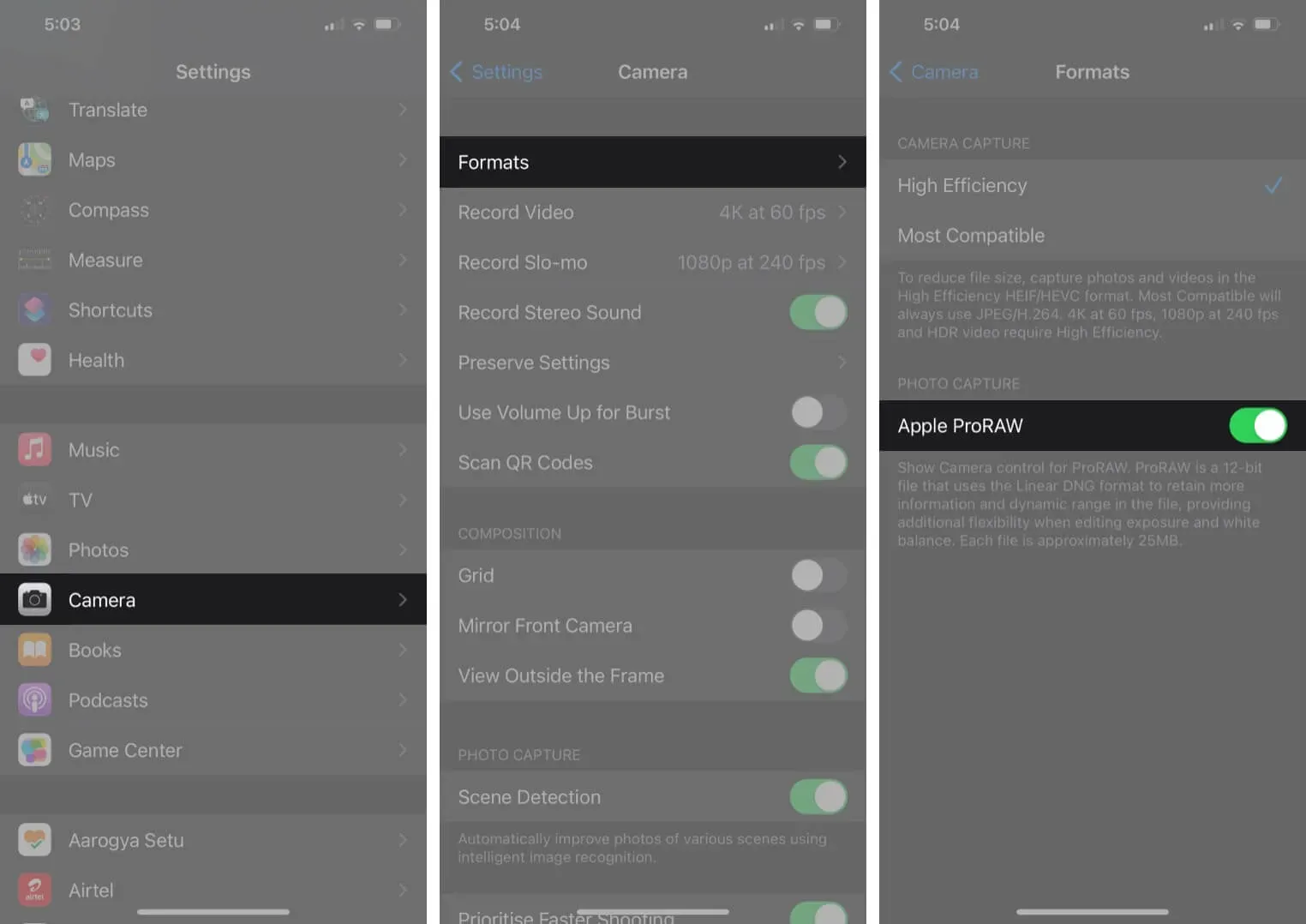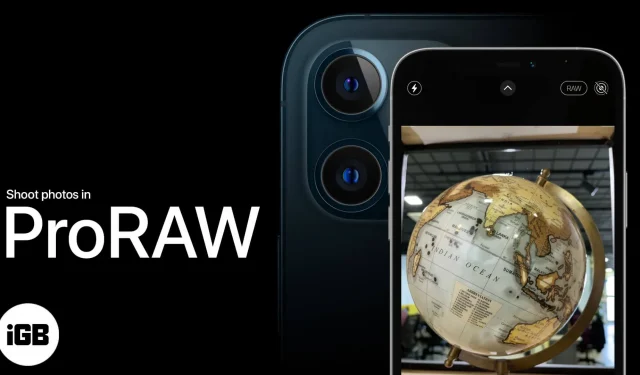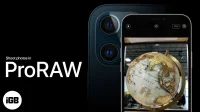The Apple ProRAW image format has been one of the distinguishing features of the iPhone 12 Pro series. From there it was continued on the iPhone 13 Pro, 13 Pro Max and the new iPhone 14 Pro and 14 Pro Max. The RAW image format used by professional DSLRs and mirrorless cameras is what Apple calls ProRAW on the iPhone.
This is the ideal shooting format when you want to do advanced editing and bring out sharp details in a frame. Therefore, you should try using ProRAW on your iPhone 14 Pro/Pro Max once. Shooting in this format is very easy. But what makes Apple ProRAW different from regular HEIC or JPEG files on the iPhone? Let’s look at it.
What is Apple ProRAW?
ProRAW is a format that gives you an edge when editing photos. It does not adjust the lighting of the image so you can enhance it in any format. In layman’s terms, if you’re shooting an image in night mode and want to brighten it up like a daytime image, you should shoot it in ProRAW mode.
You may wonder how this is even possible. This is because Apple ProRAW combines standard RAW format information with iPhone image processing. This allows you to play with the exposure, color and white balance of the image. These pictures can be edited using third-party apps or the built-in Photos app. Formatted images will be larger. Hence, they can quickly deplete your storage.
Note. ProRAW can take pictures with Smart HDR, Deep Fusion, and Night Mode, but cannot be used with Live Photos, Portrait Mode, or movie shooting.
What is the difference between RAW and ProRAW?
Most photographers prefer to take pictures in RAW mode because they get raw data when they capture. This allows them to play with the composition and let their imagination run wild. This means that RAW images are as flat as you would expect and may not look very attractive. That is why it gives you the opportunity to work on the image as much as you want. This is the beginning of computer photography.
The ProRAW mode, on the other hand, adds Apple touches to the RAW format. This means that it is a lightly processed image, so it has a better format than a RAW image. ProRAW covers the groundwork for you and gives you equal opportunity to customize your image to suit your needs. Midas touch to RAW program.
Usually when you capture any HEIC or JPEG image to your iPhone. In addition, Apple Deep Fusion technology optimizes the image before saving. This way you don’t need further editing. ProRAW is a cross between RAW and JPEG/HEIC. When shooting in ProRAW, you get a 12-bit RAW DNG file with 14 stops of dynamic range.
Also, ProRAW files are often around 25MB each due to the amount of data they contain, as opposed to the typical JPEG file size of 3-5MB and the average file size of 1-3MB for HEIC. Improved camera capabilities now enhance ProRAW by providing the cleanest source data for editing.
Improved Apple ProRAW in iPhone 14
One of the main features of the iPhone 14 Pro series is an upgraded camera with a large 48 MP sensor. In addition, Apple has added a new computational photography technology called the Photonic Engine to the iPhone that will further enhance the shots. Based on practical experience, 48-megapixel ProRAW images from the main camera will be 8064 x 6048 and 75 MB, which is 3 times larger than before.
The new quad-pixel sensor can combine four pixels into one for sharper, brighter images with less noise and unprecedented detail. As such, it can now capture highly detailed ProRAW photos and is equipped with a “new machine learning model.”The main 48-megapixel camera has a seven-element lens with an f/1.78 aperture, second-generation optical image stabilization with sensor shift (OIS) and 100% focus pixels.
How to Use Apple ProRAW on iPhone
While the internet is going crazy over the format and how to get the most out of it, this is a very simple format for capturing images. I hope you have comfortable devices, because I will walk you through the steps to use Apple ProRAW. on iPhone in real time. I can’t wait to show the endless possibilities of this format and bring out the hidden photographer in you.
To enable ProRAW, you need to check if your device is compatible with this feature or not. Your iPhone must be updated to iOS 14.3 or later; if not, update your device first and then follow the steps given below.
Turn on ProRAW mode.
- Go to Settings.
- Scroll down to Camera.
- Tap Formats.
- Turn on Apple ProRAW. You will find it in the PHOTO CAPTURE menu.

Once this is done, you can choose to capture the RAW image from the camera itself. You still have to turn it on while shooting with the built-in Camera app, even if it’s installed. This is related to the size of ProRAW files; using them for every image you take will quickly drain your device’s storage capacity.
Take ProRAW photos with your iPhone camera
- Open the camera on your iPhone.
- You will find that the RAW mode is disabled. (Top right with stroke:
RAW). Touch it to turn on RAW mode.

If you want to continuously shoot every photo with ProRAW enabled, save your settings by going to Settings → Camera → Save Settings → Toggle Apple ProRAW. I don’t recommend doing this because you may end up using up all your storage since ProRAW files are 10 to 12 times larger than HEIF or JPEG and you don’t need all the RAW photos.

That’s all. Travel to your favorite location and capture the moment in ProRAW. Here’s my favorite of the several shots I’ve taken.
ProRAW images are stored in the standard DNG format. Make sure the image is saved with the extension. dng to edit it later. They can be edited with the iPhone Photos app and any third party RAW photo editing apps that support. dng. I prefer Lightroom as I have a lot of professional features to customize the image to my liking.
Here are some of the preferred ProRAW image editing applications:
- Adobe Photoshop
- Lightroom
- Snapseed
- Apple Photos
ProRAW images can also be published with the. jpg. However, it may look different than expected because it is partially compressed to the format. jpegs. To export these images to the Apple ecosystem, send them via AirDrop or use iCloud to access them.
Does ProRAW Really Matter?
ProRAW is a decent feature if you don’t have a DSLR, want to use your iPhone as your main camera, and intend to edit images afterwards. ProRAW photos have a more subdued and smoother look than processed JPEG/HEIC images. But at first glance, you may prefer a JPEG/HEIC image because it has already been processed to look nice.
RAW and ProRAW images need additional processing to look just as good. The ProRAW format uses computational photography comparable to Deep Fusion and Smart HDR. Thus, it is better to use an image editing tool to observe the changes.
However, when you start editing a ProRAW image, you have much more control over certain features such as exposure and tone. So ProRAW doesn’t claim to be “better”than standard iPhone image formats, but there are times when you might need access to finer details and advanced editing. In light of this, the ability to shoot ProRAW images on the iPhone makes it a worthwhile investment.
FAQ
If you need to edit a photo or composition, or change the lighting of an image, click them in ProRAW format. Using an iPhone to shoot RAW creates an image between JPEG and RAW. So, take a ProRAW shot to get an image with the right base.
RAW files are stored in the. dng; they carry all the raw image data. HEIC is Apple’s photo storage method. It’s not a format per se, but a container for storing images. This means that the saved images are of better quality and take up less memory. They are stored with the extension. heic. JPEG is the most common format for storing photographs and has been in use for a quarter of a century. It is best for exporting images because it is a universal format and is available for almost any device that can open images.
RAW photos require a lot of memory. Sometimes they may look blurry due to memory overload and may not look as sharp as expected. However, you won’t experience this issue if you update iOS to 14.3 or later and macOS to Big Sur 11.1 or later as they support this format.
Yes, raw photos are tagged RAW in the top right corner.
You need to install third-party apps to capture RAW photos on other iPhones. Halide, Manual, and ProCam 8 are some of the apps you can use.
Conclusion
How do you like the ProRAW format? I really enjoyed capturing beautiful moments in this format and satisfied my creativity by editing them. Let me know your thoughts in the comments section below.


